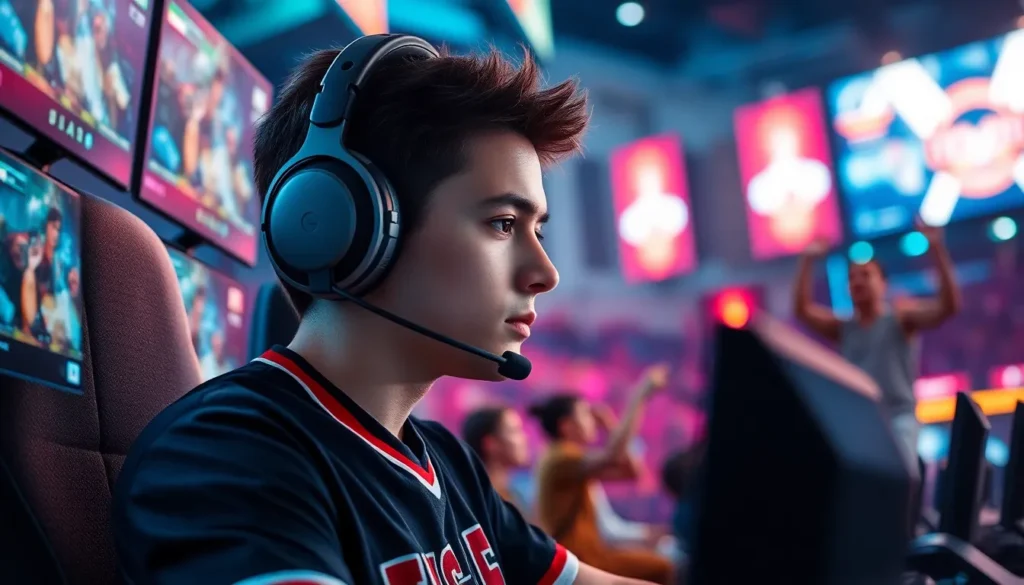Table of Contents
ToggleIn the fast-paced world of esports, rankings can feel like a rollercoaster ride—one moment you’re on top of the world, and the next, you’re plummeting down faster than a noob in a ranked match. With so many players battling it out for glory, understanding who’s who in this digital arena is crucial for fans and aspiring pros alike.
Overview of Esports Player Rankings
Esports player rankings reflect the competitive status of gamers across various titles. Understanding these rankings helps fans appreciate players’ skills and accomplishments. Players often experience fluctuations in their standings, influenced by tournament results and individual performances.
Several factors contribute to a player’s ranking. Win rates act as primary metrics, showcasing how frequently a player achieves victory in matches. Tournament placements also hold significant weight, highlighting consistency in performance. Additionally, player statistics like kills, assists, and deaths provide insights into each competitor’s skill set.
Different esports organizations and platforms maintain their own ranking systems. Websites such as HLTV for Counter-Strike: Global Offensive and Liquipedia for games like Dota 2 regularly update rankings based on the latest tournament outcomes. Some ranking systems rely heavily on the Elo rating system, calculating player strength through their match results against other players.
Despite the competitive nature of rankings, they also foster community engagement. Fans track their favorite players’ progress and participate in discussions around sudden changes in standings. Media coverage around these rankings further amplifies visibility, attracting new audiences to esports.
Player rankings serve as vital indicators of performance in the esports world. Accurate, updated standings help both viewers and aspiring gamers navigate the dynamic environment of competitive gaming. Understanding these rankings enhances the appreciation of the skill and dedication required to excel in this rapidly evolving field.
Importance of Esports Player Rankings

Esports player rankings hold significant value in the competitive gaming world, influencing various aspects of the scene. They not only reflect individual performance but also shape the overall dynamics of teams and fans.
Impact on Players
Player rankings directly affect a player’s career trajectory. Notable improvements or declines in rankings can influence sponsorship opportunities and invitations to prestigious tournaments. Players often feel increased pressure to perform consistently, which can fuel their motivation. Consistent ranking updates provide gamers with insights into their progress, encouraging them to refine skills and strategies. Rankings serve as benchmarks that aspiring players can strive for, promoting a culture of excellence within the esports community.
Impact on Teams
Teams rely heavily on player rankings to assess performance and make strategic decisions. A team’s competitive edge often hinges on the strength of its ranked players. High-ranking members attract attention from sponsors and boost team reputation. Rankings impact team composition during roster changes, as teams seek to balance skill levels for maximized success. League standings can also affect team morale; victories and losses resonate differently based on player rankings. As a result, teams must continuously analyze and adapt to the shifts in rankings to maintain a competitive advantage.
Methodology for Ranking Players
The ranking of esports players relies on systematic evaluation and comprehensive data collection. These methodologies ensure fair assessment and transparency in rankings.
Criteria for Evaluation
Win rates, tournament placements, and individual player statistics serve as primary criteria for evaluation. Players’ consistency in achieving high placements and their performance across multiple tournaments also influence rankings. Various metrics such as kills, assists, and deaths provide insights into a player’s gameplay effectiveness. Additionally, head-to-head matchups and overall contribution to team success are considered. Such multifaceted criteria help create an accurate representation of a player’s current standing in the competitive scene.
Data Sources and Analytics
Established platforms gather data from numerous tournaments to maintain player rankings. Websites like HLTV and Liquipedia regularly update statistics based on live match results. Analytics tools sift through performance data, generating insights regarding players’ strengths and weaknesses. This data-driven approach enables organizations to leverage advanced algorithms and the Elo rating system. Continuous updates from reliable sources ensure that rankings reflect the most current player performance in the rapidly changing esports landscape.
Top Esports Players of 2023
Current esports rankings showcase the top performers in the industry, reflecting their hard work and dedication. Notable players are making significant impacts across various titles.
Notable Performances
In 2023, several players stood out with remarkable achievements. Players like Oleksandr “s1mple” Kostylieva has displayed exceptional skill in Counter-Strike: Global Offensive tournaments, consistently contributing to his team’s success. Similarly, Johan “N0tail” Sundstein’s strategic mastery in Dota 2 has made him a pivotal figure during crucial matches. Achievements like these highlight the importance of individual performances, as they directly influence team standings and player rankings. Players’ consistent high placements in major events serve as a testament to their talent and commitment.
Upcoming Talents
Emerging talents in esports promise to reshape the competitive landscape. Young players such as Adil “ScreaM” Benrlitom have shown incredible potential in first-person shooters, quickly climbing the ranks in various tournaments. Teams are increasingly recognizing players like Jaccob “yay” Whiteaker, whose impressive stats and adaptability make him a formidable opponent. Their rapid rise emphasizes the evolving nature of esports, as fresh talents continually challenge established veterans. Monitoring these players offers insights into future ranking trends and showcases the dynamic environment of competitive gaming.
Trends in Esports Player Rankings
Trends in esports player rankings reflect ongoing changes in the competitive scene. Players face new challenges and adapt their strategies to stand out.
Evolving Criteria
Criteria for rankings evolve to incorporate diverse performance metrics. Win rates and tournament placements maintain significance, but player statistics such as kills, assists, and deaths gain weight. Organizations increasingly value consistency, strategic influence, and overall contribution to team success. Advanced analytics and algorithms help refine these criteria, ensuring fair assessments. Assessing multiple tournaments, platforms capture a comprehensive player picture while updating rankings regularly. Insights from this data reveal trending performance behaviors and highlight emerging talents.
Regional Differences
Regional differences significantly affect player rankings in esports. North America, Europe, and Asia showcase varying styles of play and competitive strengths. Within these regions, certain titles dominate, influencing player development and opportunities. For instance, Counter-Strike competitions in Europe consistently attract top-tier talent, while North American players focus heavily on specific shooters. Cultural aspects also shape player strategies, affecting how they approach matches. Such regional nuances underscore the importance of understanding the competitive landscape in global esports. Recognizing these differences provides valuable context for followers and aspiring gamers alike.
Esports player rankings play a crucial role in shaping the competitive landscape. They not only reflect individual achievements but also influence team dynamics and sponsorship opportunities. As players adapt to new challenges and refine their strategies, rankings continue to evolve, offering insights into the future of competitive gaming.
Fans and aspiring gamers benefit from understanding these rankings, as they highlight the dedication and skill required to excel. The ongoing analysis of player standings fosters community engagement, allowing audiences to connect with their favorite players and track their progress. With the rapid advancements in analytics and evaluation methods, the world of esports rankings remains an exciting and ever-changing arena.




